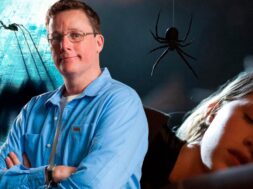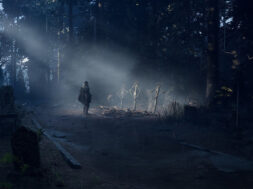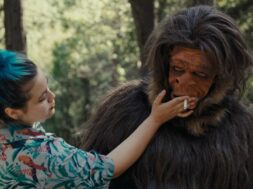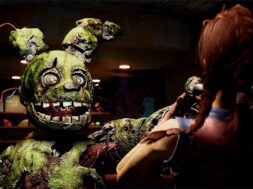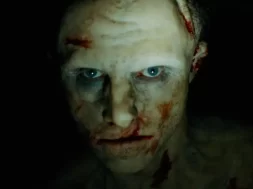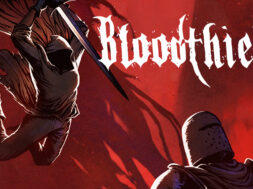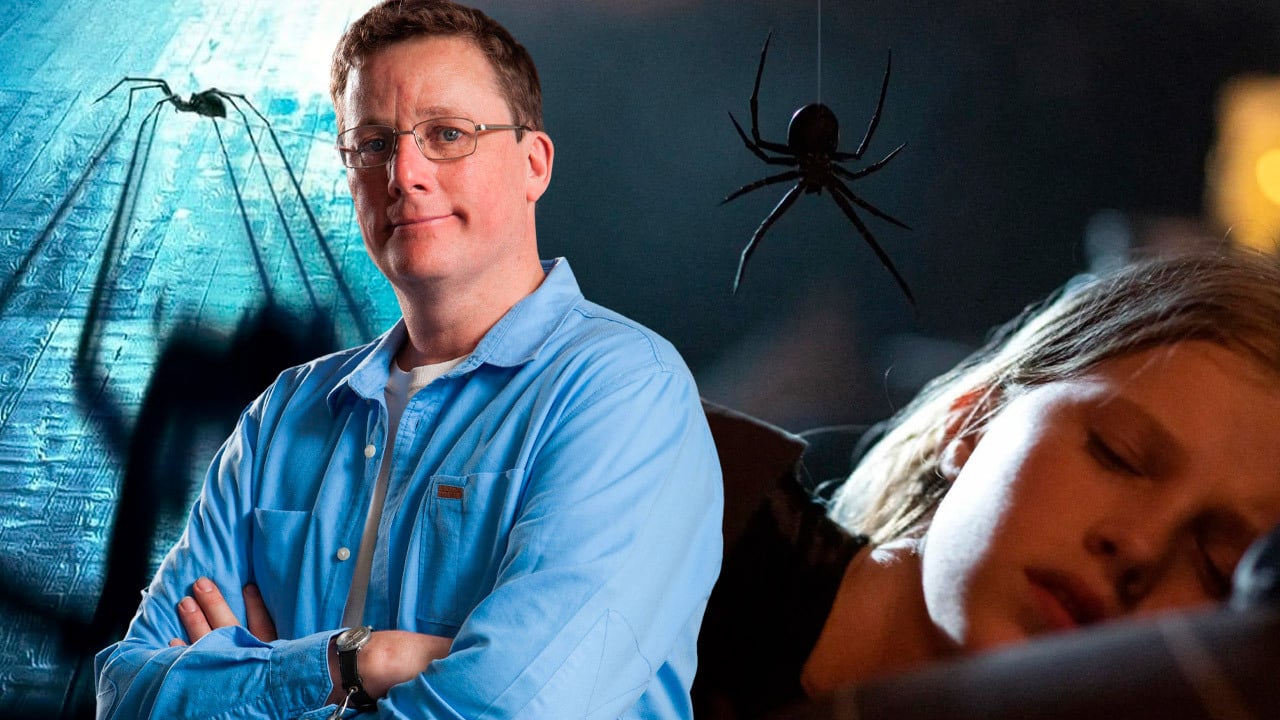
Makeup FX wizard Richard Taylor has quite possibly been “interviewing with FANGORIA longer than the people interviewing me have been alive.” That’s what happens when you’re a legend, Sir Richard! The FX guru is the co-founder of Wētā Workshop and cut his teeth on some films you may have heard of, like Braindead, aka Dead Alive, and The Lord of The Rings trilogy.
Today, he’s here to talk giant freakin spiders. Well, one giant ass spider in particular. Sting— the eight-legged beast from writer/director Kiah Roache-Turner’s upcoming spider horror movie of the same name.
When you were initially approached to create a giant monster spider, I imagine you had several different images in mind. There are multiple directions you can go. Where did you begin, and were there any concepts that you threw out?
When Kiah first contacted us and told us he wanted to make a monster spider, of course, our minds went racing, and we were visualizing some hybrid alien, fantastical, kooky, crazy creature that is somewhat spider, somewhat alien-like invention. But of course that’s not where it went because very quickly Kiah confirmed for us the direction in which he wanted. And so there wasn’t exploratory work done around any wild designs.
It’s funny, we’ve done other spider jobs for directors, and they always know exactly the type of arachnid that scares the shit out of them. That is specific. And every person we’ve talked to over the years has a different type of arachnid. Some are thick limbs with lots of hairs that have a very chitinous quality; others are skinny and highly reflective.
Kiah fell into the very skinny, highly reflective, hard surface, limited number of hairs right down to talking about how the creepy joints work on the limbs.
So the only real adaptation from the original brief was that it was a redback spider, and that came quite quickly. There were obviously early discussions: oh, well, am I being brave enough, and should I do something a bit more radical? Or is a spider going to suffice, and so on.
But he quickly settled on a redback of exact proportions because that gave him the creeps, and then it was really only the face that he had a momentary pause on and then came up with the idea of it having this very large mouth that could fit around someone’s neck. It stayed true to the original concept, which is fantastic when you’re working on a low-budget, fast turnaround project.
What’s the spider that scares the shit out of you? Furry or lanky?
I’m not an arachnophobe at all! I think that’s a product of growing up in New Zealand where we don’t have venomous spiders. We have one tiny little spider called a katipō , which has a red dot on its back, and if you had a very poor heart and were bitten multiple times by it, it might do you in. But other than that, it’ll just give you a nasty bite.
But I’ve never been bitten by one, so I feel very comfortable picking up spiders in New Zealand and putting them outside or just living with them. I’m sure if I grew up in Australia and had things the size of a house cat walking around in the lounge, I would be very, very differently minded.
Some friends that have either immigrated to Australia or grew up there have told me some crazy stories about spiders, which do give me the shudders, and Kiah’s description of his fear of spiders was certainly one to induce fear. But now I’m imagining that once one of our staff reads your article where I say, “I’m not an arachnophobe,” they’re going to set up some gag at work that completely reverses that.

What is your research process when your work is based on something real and then amplifying it rather than creating a creature from scratch? Are you looking at pictures and videos?
Yeah, exactly. It’s intense. Ecological plausibility is one of the things we’re trying to find with our creature work, whether it’s a fantastical creature, like a fell beast or a spider for Kiah’s film, we’re trying to make sure that our designs are plausible even though they may be fantastical.
In this case, the fantastical qualities come through the scale of the spider, how quickly it grows, and the structure of its face. But the efforts are still to try and make it such that the audience believes that it exists as a real biological creature.
I’m yet to see whether we’ve achieved that or not. Ultimately, we want to make a character first and foremost for anything that we make. This is an alien spider that has to perform as a character alongside the actors and not just be a puppet on a set where the audience can’t suspend their disbelief. We want the audience to find it plausible that this is a creature within the movie as opposed to a puppet on a set.
That’s what I always look out for when I watch our work and see whether our puppeteers have achieved that and whether the thing we built gave them the tool to try and achieve that.
I’m hoping that the complexity of the mechanisms and the problem-solving that we put in at a workshop level will deliver something that has the ability to elevate above it being a puppet to become a character, a creature.
It very much feels like Sting has motive.
That’s actually the right thing that we want is that it feels like it has a motive! I use the term in our workshop of “malicious intent.” An animal does not have malicious intent, right? An animal has animalistic intent. Where it’s just for its very survival and its very intuition with respect to hunting for food source, but humans and therefore things like orcs and Irukai and other critters that we may have got to build, have to ascend above just being animalistic and induce a sense that it’s got malicious intent, that it’s intellectually processing this.
If it were just a spider, it would be animalistic, hunting for food. But because it’s an alien, we wanted to try to evoke the sense that it enjoys hunting for food and disposes of its victims through venom, through spitting venom.
If it’s not bad enough just to bite someone, well then I’m going to bloody well spit it in their faces, dissolving people, et cetera. We do deep research and watch videos. There’s so much spectacular close-up video footage of all insects in the world that a spider is a very easy thing to research.
Then you start to share those videos with the director, so you figure out the specificity of what they want. By chance, we had built a spider for a traveling bug exhibition. I think it was at Melbourne’s museum at one point, and we’d actually built a spider of similar scale to Sting, so we were actually able to use that as an example in phone calls with Kiah, and very quickly established what he was after.
I’m just imagining kids in the museum losing their minds at this thing.
We built a series of bugs at a very large scale and then unpacked the crazy-ass story about what these specific bugs do, and yep. The trick with an exhibition like that is to try and create fascination so that kids don’t squash bugs. We’ve got to stop squashing. Everything has a place in the world’s ecology, so maybe Sting’s going to reverse all of the good work we’ve ever put in!
Sting is completely ruining the anti-squashing campaign. One hundred percent.
There’s a headline right there.
We see Sting change throughout this movie. How many versions of Sting did you and the team build?
We only built one large articulated Sting. We did other smaller printed Stings. I’m interested to see how Kiah actually used our one large Sting to scale for the different sizes of Sting. I’m assuming that he’s used the wonderful CG work of the digital team to do the various sizes.
We did do little tiny characters for him. I can’t actually comment on how the practical ones are being used, but ultimately one big bugger that just romps around doing damage. The greatest challenge for a puppet of a spider is the puppeteers’ coordination to get all the legs, the body, and the body’s tracking on a dolly rig while the radio control operator is moving the thorax independently.

The head is moving, the pedipalps are articulated, the fangs are moving, the pumping of the liquid is happening, and then you’ve got to get eight legs with four joints per leg, all moving in synchronization.
So we slaved some of the joints together through bell cranks within the legs, but it still requires the coordinated efforts of three puppeteers. We actually sent our head engineer Joel over to run the puppet. He had been practicing so much with it in the workshop, and then we hired a New Zealand puppeteer who we’ve worked with a lot, who’s an amazing contemporary dancer, contortionist, and ribbon gymnast, but also a great puppeteer called Tans Durie.
We also hired an Australian puppeteer, Kayla, who came in and joined that troupe, and then I think anyone on set who had an available hand also chipped in to move a spare leg. There were eight legs, so yeah, very tricky.
I love that you used the word troupe because it is kind of like a dance troupe; the choreography involved to make sure Sting is in sync.
Yeah. It falls over and fails. Any puppet you build falls over and fails if the puppeteers can’t work as a coordinated group, symbiotically synced in as one brain.
It sounds a bit over the top, but you look at even the simplest puppets using more than one performer. It’s hard enough doing this and then moving this around, coming from your own brain, but getting three, four people doing it all at once. Very tricky.
It is like a balletic choreographed performance. Now, the challenge there is that every new day, the director will ask for a different set of performances from the puppet, and you only have time to rehearse right before the shot.
Before the camera rolls, you try to sync up your performances. You use different mechanisms. Someone might call out a metronome of one, two, one, two, one two, or you talk it through with each other, and then you just try and sync mentally. That defines whether you’ve got a disconnected puppet or a coordinated creature.
Sting is now in theaters. For more, check out all the horror movies you can watch in theaters this weekend and upcoming horror movies we’re looking forward to this year.
